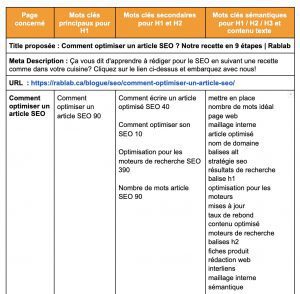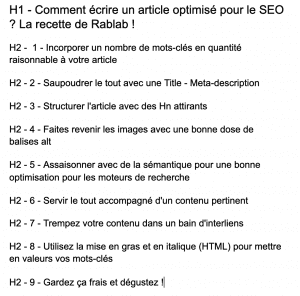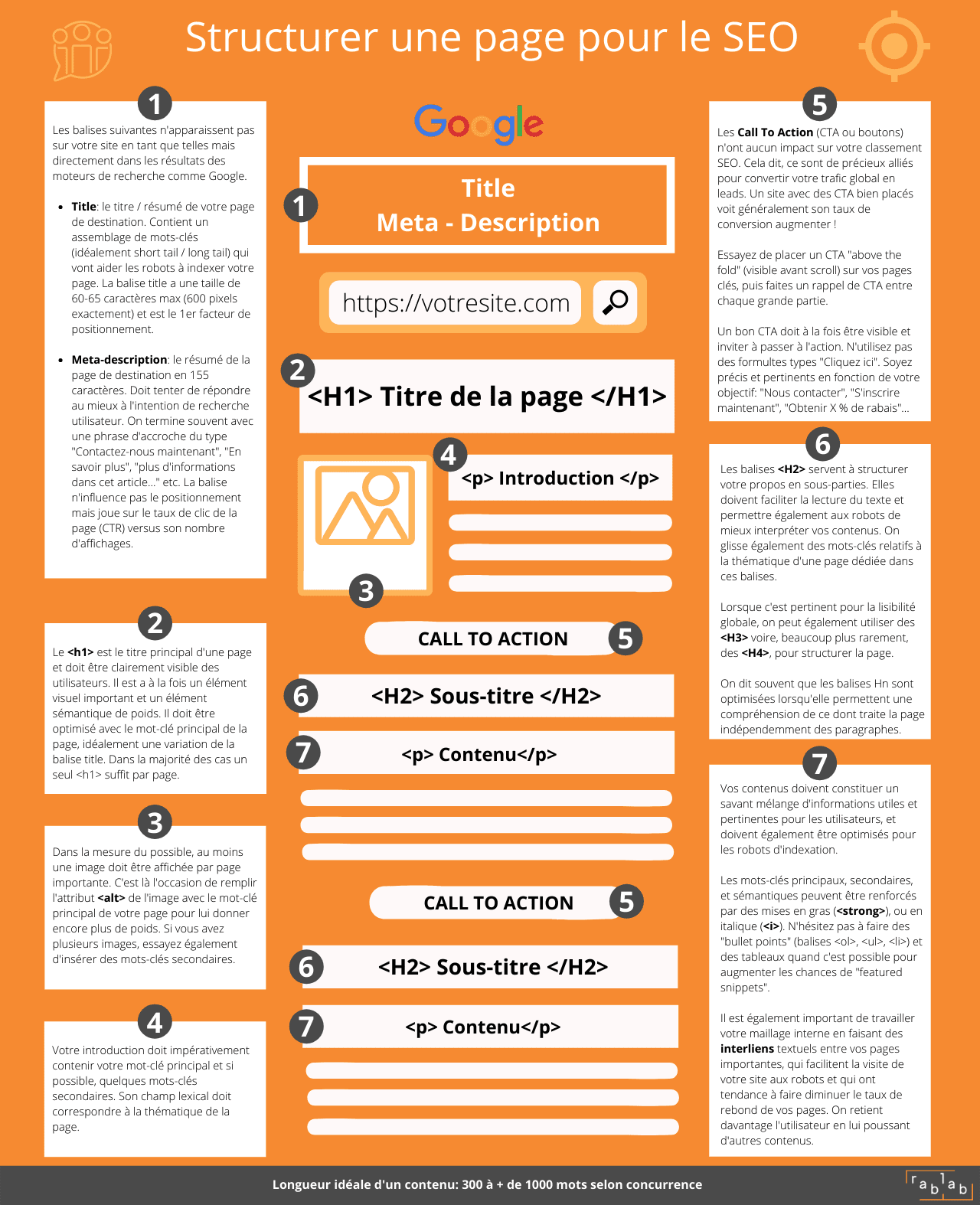We keep telling you at Rablab and everywhere else: in SEO, content is king.
There have been updates, algorithmic changes that have more or less changed the way search engine rankings work. Hundreds, if not thousands, since organic referencing has existed. Google continues to refine its formula in an attempt to offer increasingly relevant results to Internet users.
Yet the importance of content has never been devalued by the Silicon Valley giant. Conversely, the weight of quality content tends to become an increasingly important ranking factor as the years go by.
This is where you tell me “Ok! But, what is good SEO content in 2021?”
And I will answer you “Don’t move, it’s coming. Let me introduce you Rablab’s recipe as if you were in your kitchen ready to cook up a nice little dish”.
1 – Include a reasonable number of keywords in your article
The first step is to select quality keywords that will serve as the structure of your article. Ideally, you want to find keywords with good search volume and a reasonable competition level. Do not hesitate to look at long tail keywords to obtain interesting results in the shorter term.
At Rablab, we use a great keyword research tool called SEMRUSH. That said, it’s a paid tool. To search keywords for free, other options exist. I’m thinking in particular of the good old Google Ads Keyword Planner.
Once you have the tool, the search begins. You can start from a topic you have in mind by analyzing search volumes for specific keywords. Or, you can start by exploring options with your keyword research tool from the chosen topic.
For example, to find the subject of this article, I didn’t search too far. I simply typed the word “SEO” into my tool.
After 5 minutes spent filtering the keywords to explore the possibilities, the topic was found.
“Wait a minute! Are you really explaining how to write for SEO using this article as an example?”
Once your main query has been found, you will be able to look for secondary keywords to strengthen your semantics. While researching the query “optimize SEO article”, SEMRUSH returned some interesting phrases to add to my article.
I have sorted this out in a nice table that I am sharing with you here, and that our customers are familiar with:

I will not go further on keyword research. Quite simply because Rablab has already a complete article entitled “How to choose the right keywords for your website SEO ?”.
I invite you to read it. It will make a great addition to this article.
Once your list of keywords has been established, you will need to integrate them into your article. No need to repeat them at the beginning of each sentence, it would even be counterproductive. Just make sure they appear naturally in important tags on your page, and in body text.
This will be the best practice for SEO optimization for search engines.
“Ok pause. Wasn’t the bold phrase above in your list of keywords?”
Finally, we generally recommend a keyword density between 2 and 5% of the total words of your article.
2 – Sprinkle everything with a Title – Meta-description
Now that you have the material, it’s time to enter the kitchen.
Before you tackle the main content of your article, you can focus on two of SEO’s hottest tags. I’m talking about the title tag, and the meta-description tag.
The idea will be to fill these tags with your main keywords while respecting Google guidelines.
Once again, our blog has already an article entitled “How do I create optimized title and meta description tags?” which you might want to read before continuing.
Let me just give you an overview of the title / meta description tags of this article to get a sight of the correlation with my keyword research.

3 – Structure the article with explicit Hn
We are getting closer to the central part of the recipe: the content itself!
I am giving you a personal technique here, but you are free to find your own way. When I write an SEO article, I like to start my optimizations with the Hn tags.
The Hn tags correspond to the titles of your parts and your paragraphs. There are six of them, the most important being the H1 tag, and the least important, the H6 tag.
The H1 tag is generally unique, while the other tags very often appear in multiple instance. At Rablab, we tend to use H1, H2, H3, or even H4 tags depending on the importance of the content. Roughly speaking, the more subparts there are, the more you can increment your Hn tags. Unless you post an online essay about nuclear physics, you rarely use H5 and H6 tags.
So, here’s the structure used to write this article:

Looking closely, you’ll find that these Hn tags are made up of a mix between the searched keywords we talked about earlier and words that came naturally.
This is the tip that closes this section: optimize your Hn tags with keywords but make sure that they keep a minimum of meaning for the reader!
4 – Use a healthy dose of alt tags on your images
A good SEO article ideally include a few images related to your main topic.
Make sure to optimize their weight / size, so that the loading speed of your site is not affected. Name your images with a relevant title while lowercase, avoiding accents, and using the “-” to separate different words.
And above all, do not neglect the alt tags of your images !
The Alt tag is alternative text that describes an image and is displayed when it cannot be loaded. The goal is to describe your images by inserting one or more relevant keywords in its alt tag.
This tag has a rather weak influence in the search engine ranking algorithm, but it helps to increase the quality of your content in the eyes of Google if filled in correctly. You would be wrong to omit this step!

Curious about the alt tag for this image? Right-click on the image, then “inspect the element” to discover it!
5 – Season with relevant content
Once your Hn structure has been validated, you have the frame of your article! Now you have to write the contents within the different sections.
Your goal shouldn’t be to just pile up popular keywords. This technique is no longer working since over 15 years. You must ensure that you maintain a good chemistry between the different components of your content, with:
- Searched keywords,
- Rich and informative content, preferably long and relevant (minimum 500 words or more depending on the competition).
Here is an estimate of the trends in 2021 by type of page:
- 350 words minimum for product / collection pages,
- 500 words minimum for service pages,
- 700 words and (much) more for blog articles.
You need to keep both the crawlers and your visitors happy. They must find the information they are looking for directly in your content. Give them as much relevant detail as possible, and you will gradually lead them towards conversion.
This is valid for a lead generation (forms, calls, etc.) website as well as for an e-commerce.
In the case of a lead-gen site, you will optimize the content of your services / blog / home pages as a priority. For a merchant site, it will be a question of expanding the texts of your category pages and product listing, and of your possible blog.
6 – Serve everything accompanied by semantic keywords
Semantic keywords help algorithms to better understand the content of your site. In other words, they constitute the lexical field of your article.
Still taking the current article as an example, if my main keyword is “How to optimize an SEO article?”, My semantics concern everything that closely or remotely relates to this theme:
- Title,
- Meta-description,
- Hn Tags,
- Keywords,
- Number of Keywords,
- Alt Tag,
- Search engines,
- Links,
- Etc…
So many words which support my main theme and which will help Google to interpret it well.
Obviously, these semantic keywords will have more weight placed in relevant and informative sentences.
If you want more information, Christophe, our great web marketing guru, has put together an article to explain in detail the different types of keywords in SEO and their roles.
7 – Soak your content in a bath of interlinking
In SEO, what is called internal linking is of great importance.
You should know that crawlers follow all the links that you create between the pages of your site. Apart from your menu / footer, the textual links you put in your content are very important. They make indexing easier, and help robots know what your pages are about.
You need to do your best to have a great interlinking to make the bots’ job as easy as possible. Avoid, with some exceptions, neutral link anchors such as “click here”, or “learn more”. Rather, make sure you provide an overview of the topic of the page you’re linking to.
If you want good examples of SEO optimized links, you can check out those in this article.
8 – Use bold and italics (HTML) to highlight your keywords
The strong tag is a semantic HTML tag. Its function is to signify that a specific part of the content is of great importance for the meaning of the text. By default, this tag bolds the words it contains. It therefore gives the words in question a visual importance as well.
You can therefore use it to reinforce the weight of your main and secondary keywords, and of your semantics. Do not put your keywords in bold each time they appear, in order to avoid over-optimization. 1 or 2 boldings per important keyword seems to be a good ratio.
Same principle for the em tag (italics) which will rather serve to reinforce the importance of the lexical field related to your theme. In other words, your semantics.
Note: do not confuse these tags with the HTML <b> (bold) and <i> (italic) tags which have no semantic weight. The same goes for bolding or italics via CSS, which has no weight in SEO.
9 – Keep it fresh and enjoy!
You now have all the cards in hand to effectively write seo-friendly content.
But I have one last piece of advice for you, and not the least.
While it’s true that SEO-friendly content from the start will bring you lasting traffic, the freshness of the content is also important.
Do not hesitate to regularly update your old content, and to publish new ones frequently (via a blog for example). Google likes recent and updated content. This tells its robots that your site is alive and up to date. Conversely, a site that has never been updated will tend to be less visited by “crawlers”, and therefore will not rank as well.
Finally, if you need help writing your content, do not hesitate to contact us. We will be able to provide semantic optimizations as part of a SEO strategy dedicated to your business. If relevant, we can also suggest SEM, SMM, and programmatic strategies.
I leave you with a magnificent infographic “made in Rablab” which sums up everything I have just said.
Cheers!
Julien, Head of SEO performance.

Recent articles
The Google Search Console and its usefulness in SEO
Screaming Frog Seo Spider, your crawler for SEO
Amazon Ads for your e-commerce: yes or no?
Most viewed articles in recent months
10 examples of effectivecall to action
SEO and SEM: the differences between two complementary web strategies
Facebook advertising vs Instagram advertising
{
“@context”: “https://schema.org/”,
“@type”: “Recipe”,
“name”: “COMMENT ÉCRIRE UN ARTICLE OPTIMISÉ POUR LE SEO ? LA RECETTE DE RABLAB !”,
“image”: [
“https://rablab.ca/wp-content/uploads/2021/03/optimiser-article-seo-moteurs-recherches.jpeg”
],
“description”: “Laissez-moi vous présenter la recette de Rablab comme si vous étiez dans votre cuisine prêt à concocter un bon petit plat”,
“keywords”: “Comment optimiser un article SEO”,
“author”: {
“@type”: “Person”,
“name”: “Julien C.”
},
“prepTime”: “PT180M”,
“cookTime”: “PT30M”,
“totalTime”: “PT210M”,
“nutrition”: {
“@type”: “NutritionInformation”,
“calories”: “0 cal”,
“fatContent”: “0 g”
},
“datePublished”: “2021-03-18”,
“recipeCuisine”: “Recette SEO”,
“recipeYield”: “1”,
“aggregateRating”: {
“@type”: “AggregateRating”,
“ratingValue”: “5”,
“bestRating”: “5”,
“worstRating”: “1”,
“ratingCount”: “183”
},
“recipeCategory”: “appetizer”,
“recipeIngredient”: [
“Title”,
“Meta-Description”,
“Balises Hn”,
“Balises strong”,
“Balises em”,
“Balises alt”,
“Mots-clés”,
“TREMPEZ VOTRE CONTENU DANS UN BAIN D’INTERLIENS”,
“UTILISEZ LA MISE EN GRAS ET EN ITALIQUE (HTML) POUR METTRE EN VALEURS VOS MOTS-CLÉS”
],
“recipeInstructions”: [
{
“@type”: “HowToStep”,
“text”: “INCORPORER UN NOMBRE DE MOTS-CLÉS EN QUANTITÉ RAISONNABLE À VOTRE ARTICLE”,
“url”: “https://rablab.ca/blogue/seo/comment-ecrire-un-article-optimise-seo/#incorporer-mots-cles/”,
“image”: “https://rablab.ca/wp-content/uploads/2021/03/infographie-structure-article-seo-768×752.jpg”
},
{
“@type”: “HowToStep”,
“text”: “SAUPOUDRER LE TOUT AVEC UNE TITLE – META-DESCRIPTION”,
“url”: “https://rablab.ca/blogue/seo/comment-ecrire-un-article-optimise-seo/#title-meta-description”,
“image”: “https://rablab.ca/wp-content/uploads/2021/03/title-meta-description-seo.png”
},
{
“@type”: “HowToStep”,
“text”: “STRUCTURER L’ARTICLE AVEC DES HN EXPLICITES”,
“url”: “https://rablab.ca/blogue/seo/comment-ecrire-un-article-optimise-seo/#hn-explicites”,
“image”: “https://rablab.ca/wp-content/uploads/2021/03/balises-hn-1024×1009.png”
},
{
“@type”: “HowToStep”,
“text”: “FAITES REVENIR LES IMAGES AVEC UNE BONNE DOSE DE BALISES ALT”,
“url”: “https://rablab.ca/blogue/seo/comment-ecrire-un-article-optimise-seo/#balises-alt”,
“image”: “https://rablab.ca/wp-content/uploads/2021/03/title-meta-description-seo.png”
},
{
“@type”: “HowToStep”,
“text”: “ASSAISONNER AVEC UN CONTENU PERTINENT”,
“url”: “https://rablab.ca/blogue/seo/comment-ecrire-un-article-optimise-seo/#contenu-pertinent”,
“image”: “https://rablab.ca/wp-content/uploads/2021/03/balise-alt-seo-1024×674.jpg”
},
{
“@type”: “HowToStep”,
“text”: “SERVIR LE TOUT ACCOMPAGNÉ DE MOTS-CLÉS SÉMANTIQUES”,
“url”: “https://rablab.ca/blogue/seo/comment-ecrire-un-article-optimise-seo/#mots-cles-semantiques”,
“image”: “https://rablab.ca/wp-content/uploads/2021/03/infographie-structure-article-seo.png”
},
{
“@type”: “HowToStep”,
“text”: “TREMPEZ VOTRE CONTENU DANS UN BAIN D’INTERLIENS”,
“url”: “https://rablab.ca/blogue/seo/comment-ecrire-un-article-optimise-seo/#maillage-interne”,
“image”: “https://rablab.ca/wp-content/uploads/2021/03/infographie-structure-article-seo.png”
},
{
“@type”: “HowToStep”,
“text”: “UTILISEZ LA MISE EN GRAS ET EN ITALIQUE (HTML) POUR METTRE EN VALEURS VOS MOTS-CLÉS”,
“url”: “https://rablab.ca/blogue/seo/comment-ecrire-un-article-optimise-seo/#gras-italique”,
“image”: “https://rablab.ca/wp-content/uploads/2021/03/infographie-structure-article-seo.png”
}
]
}

